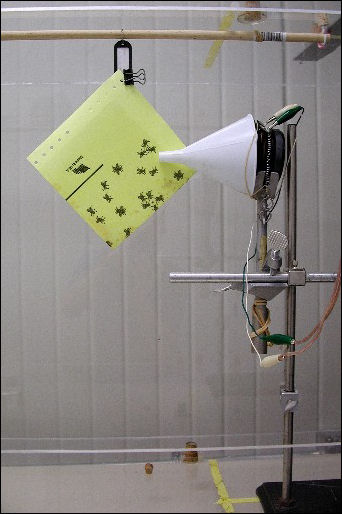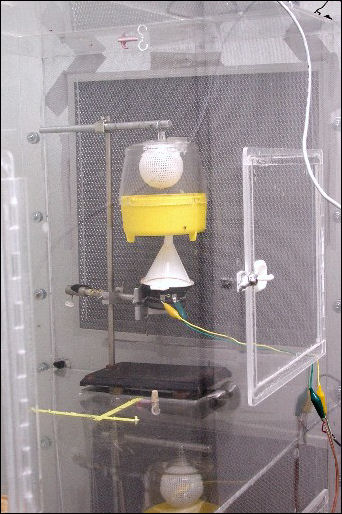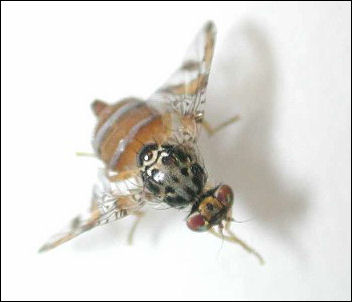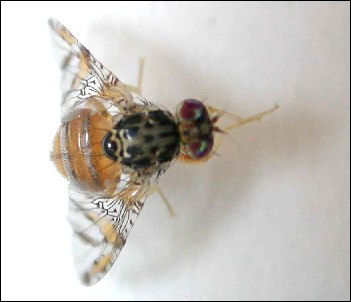|
While working at the USDA in Gainesville, Florida, I worked to evaluate the effectiveness of newly developed acoustic techniques for trapping female Mediterranean fruit flies. The traps I created incorporated the courtship song of the male medfly, which was played back using a loudspeaker set up in indirect contact with either a sticky paper or multilure trap. It is hoped that this new trapping method will increase the numbers of unmated females lured into the traps.

A close-up look at the apparatus directing male song toward a sticky paper trap. The black object on the right is a small loudspeaker that reproduces the male's sound, which is transmitted to the paper via the funnel. (The "song" is made by the male's wing beats.) |

A look at a multilure medfly trap set up with the male's courtship song being played into it from below. The white ball in the center of the trap houses 4 male flies which emit pheromones to increase the trap's attractiveness to females. |

A magnified view of a female medfly, showing the ovipositor which projects from the abdomen.. (Actual length of the female is about 6 mm.) |

A magnified view of a male medfly. (Actual length of the male is about 6 mm.) |
Response of the Female Medfly, Ceratitis capitata, to the Playback of the Male Mating Call during Bioassay Experiment
Preventing infestations of the Mediterranean fruit fly, Ceratitis capitata, has cost the United States over $800 million yearly. Previous monitoring methods only trap male and mated-females and do not efficiently trap virgin and re-mating female flies. A potential way to attract the virgin and remating flies is to attract them to an "artificial male", using a new trapping method that broadcasts a recorded male calling song. Initial studies in bioassay chambers by Postdoctoral Associate James Anderson resulted in more female flies attracted to sticky paper next to a speaker broadcasting a recorded male call than to a sticky paper near a silent apparatus or sticky paper by itself. The results of new experiments I conducted suggest that the traps with broadcasted sound continue to attract more flies than a silent apparatus-control, or sticky paper. In the new experiments the effect of sound was not statistically significant. This may be a result of the remodeled bioassay chambers. Since the sample size was only six, more experiments should be run that reduce the effects of specific confounding variables. This may increase the significance of sound and confirm the original study. In another set of experiments male medflies were enclosed in mesh containers near the sound and control apparatuses. The prediction is that males releasing sex pheromones near the broadcast song will attract more females than males without the song or a control without the song or males. The results are inconclusive because a larger sample size is needed.
Richard Mankin, who has acoustic recordings for many insects on his website, was my mentor at the USDA.
Also check out recent fruit fly papers by Dr. Vargas in Hawaii.
|